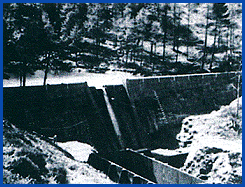
The Elan Valley dams
The Dambusters connection
A small tributary of the River Elan, which joined it about half a mile upstream from the Caban Coch dam site, was to earn a place in the story of one of the most famous episodes of the Second World War, the Dambusters Raid of 1943.
A small masonry dam was built across the Nant-y-Gro stream in the early stages of the construction of the dams and reservoirs in the Elan Valley. This dam created a million gallon reservoir on the rocky slopes above Caban Coch which was used to provide a water supply fed by a pipeline to the navvies village below. The supply also filled water storage tanks used by the locomotives, steam cranes, stone cutting machines and other steam driven plant in the two valleys.
dam in 1942,
showing slight
damage from
first explosive
trials
 After the completion of the waterworks
scheme the Nant-y-Gro dam was no longer needed, because the permanent
stone-built Elan Village which replaced the temporary navvies
village obtained a water supply under the new scheme. The Nant-y-Gro
dam, however, was still intact at the time of the war, when the
government requested the use of the 35 feet high dam for secret
experiments.
After the completion of the waterworks
scheme the Nant-y-Gro dam was no longer needed, because the permanent
stone-built Elan Village which replaced the temporary navvies
village obtained a water supply under the new scheme. The Nant-y-Gro
dam, however, was still intact at the time of the war, when the
government requested the use of the 35 feet high dam for secret
experiments.These were linked to the wartime military objective of breaching
a series of large dams in the Ruhr Valley in Germany in order
to disrupt armaments production in the industrial heartlands
of the Ruhr below the dams.
A great deal of highly secret experimental work was being carried
under the direction of Barnes Wallis, an aeronautical engineer,
and the Nant-y-Gro dam, though much smaller, provided a valuable
testbed for devising a practical means of breaching the huge
Mohne, Eder and other masonry dams.
A further advantage of the use of the Elan Valley site was its
remoteness, ideal for top secret trials without fear of being
observed.
There are 4 pages on the Dambusters connection. Use the box links below to view the other pages.